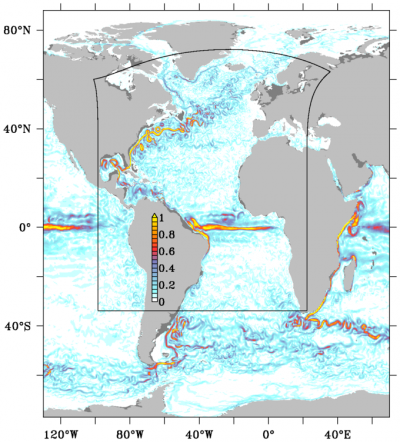Page path:
- Home
- Research
- Ocean and Climate
- Projects & Collaborative Groups
- RACE
- Theme 3
- WP 3.1: Changes of the Atlantic circulation systems in high resolution ocean models: regional impacts and global projections
WP 3.1: Changes of the Atlantic circulation systems in high resolution ocean models: regional impacts and global projections
PIs:
Claus Böning, GEOMAR Kiel, cboening(at)geomar.de
Arne Biastoch, GEOMAR Kiel, abiastoch(at)geomar.de
Team:
Markus Scheinert, GEOMAR Kiel, mscheinert(at)geomar.de
Klaus Getzlaff, GEOMAR Kiel, kgetzlaff(at)geomar.de
Rafael Abel, GEOMAR Kiel, rabel(at)geomar.de
Claus Böning, GEOMAR Kiel, cboening(at)geomar.de
Arne Biastoch, GEOMAR Kiel, abiastoch(at)geomar.de
Team:
Markus Scheinert, GEOMAR Kiel, mscheinert(at)geomar.de
Klaus Getzlaff, GEOMAR Kiel, kgetzlaff(at)geomar.de
Rafael Abel, GEOMAR Kiel, rabel(at)geomar.de

Snapshot of daily mean near surface speed at 100 m depth [m/s] based on the numerical model configuration VIKING20x. Highlighted is a subregion of the global field with the boarders of the high-ressolution 1/20° nest covering the Atlantic from 70°N to 34°S (black lines).
The high-resolution global ocean-ice-model system developed during the preceding project phase will be used for simulations focusing on regional high-resolution refinements evaluating the predicted changes for the 21st century derived from climate studies (CMIP5) projecting trends in the atmospheric forcing fields. The idea is to decipher the basic causes (1) and regional effects (2) of (multi-)decadal changes in the Atlantic circulation system based on a collection of numerical model simulations. In doing so, the main goal is to perform much more refined and horizontally higher resolved simulations of possible future trends as a consequence of the projected anthropogenic changes in the oceanic forcing parameters derived from coupled climate model simulations. The scientific goals are:
Concerning the basic causes (1) the focus is on further clarification of potentially important factors of influence for the Atlantic meridional overturning circulation (AMOC), particularly:
Concerning the basic causes (1) the focus is on further clarification of potentially important factors of influence for the Atlantic meridional overturning circulation (AMOC), particularly:
- The relative importance and possible interaction of northern- and southern hemispheric influences on the generation of decadal variability and long-term trends.
Concerning regional effects (2) the analysis focus on the manifestation of natural variability in the Atlantic circulation systems as well as possible effects of future anthropogenic trends. Of major interest are:
- The manifestation of large-scale circulation changes, particularly of the AMOC, the subpolar gyre of the North Atlantic and the subtropical-tropical cells (STCs) in regional velocity fields.
- Changes in local hydrography due to changes in the circulation system as well as trends, particularly along the continental shelfs.
- Ápplication of high-resolution model results to the interpretation of marine biological findings, particularly due to the possibility to use the time variable velocity fields to determine propagation pathways of (virtually-)passive drifting organisms.


